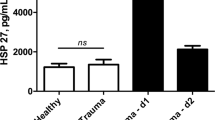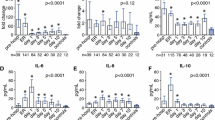Abstract
Danger-associated molecular patterns (DAMPs) are activated by endogenous signals that originate from stressed, injured, or necrotic cells, signifying “danger” to the host. In this study, we evaluated the expression of the DAMP heat shock protein 70 (HSP70) in trauma patients with and without secondary infections. Levels of glucose (GLU), procalcitonin (PCT), total cholesterol (T-Chol), and white blood cell (WBC) counts were also evaluated at three time stages after trauma. Our analysis showed that the levels of serum HSP70 in patients with minor, moderate, and severe injuries were significantly higher than in healthy patients at each time point post-injury (P < 0.01), and levels of serum HSP70 in the severe injury group were significantly higher than in the minor injury group at 1–6 h after trauma (P = 0.047). HSP70 was correlated with GLU and was negatively correlated with T-Chol in the period 1–6 h after injury (P = 0.008/0.032). WBC and GLU were elevated after trauma, with mutual positive correlation (P < 0.001). PCT levels increased later than WBC counts and GLU levels; these levels were correlated at the two later time periods, 24–48 h and 60–90 h (P = 0.008/0.041). PCT continued to rise in patients with secondary infection, but PCT dropped at the third time period in patients without secondary infection. In summary, our results suggest that danger and stress theory can be used to predict severity of trauma.




Similar content being viewed by others
Abbreviations
- DAMPs:
-
Danger-associated molecular patterns
- HSP70:
-
Heat shock protein 70
- PCT:
-
Procalcitonin
- GLU:
-
Glucose
- WBC:
-
White blood cell
- T-Chol:
-
Total cholesterol
- ED:
-
Emergency department
- ISS:
-
Injury Severity Score
- PAMPs:
-
Pathogen-associated molecular patterns
- PRRs:
-
Pathogen-recognition receptors
References
Masella CA, Pinho VF, Costa Passos AD, Spencer Netto FA, Rizoli S, Scarpelini S (2008) Temporal distribution of trauma deaths: quality of trauma care in a developing country. J Trauma 65(3):653–8
Larsen AI (2012) Clinical and biomarker profile of trauma-induced secondary cardiac injury. Br J Surg 99(6):797–8
Hwang PF, Porterfield N, Pannell D, Davis TA, Elster EA (2011) Trauma is danger. J Transl Med 9:92
Pradeu T, Cooper EL (2012) The danger theory: 20 years later. Front Immunol 3:349
Di Virgilio F (2005) Purinergic mechanism in the immune system: a signal of danger for dendritic cells. Purinergic Signal 1(3):205–9
Bianchi ME (2007) DAMPs, PAMPs and alarmins: all we need to know about danger. J Leukoc Biol 81(1):1–5
Gallucci S, Lolkema M, Matzinger P (1999) Natural adjuvants: endogenous activators of dendritic cells. Nat Med 5(11):1249–55
Matzinger P (1998) An innate sense of danger. Semin Immunol 10(5):399–415
Asea A, Kraeft SK, Kurt-Jones EA, Stevenson MA, Chen LB, Finberg RW, Koo GC, Calderwood SK (2000) HSP70 stimulates cytokine production through a CD14-dependant pathway, demonstrating its dual role as a chaperone and cytokine. Nat Med 6(4):435–42
Gallucci S, Matzinger P (2001) Danger signals: SOS to the immune system. Curr Opin Immunol 13(1):114–9
Wallin RP, Lundqvist A, Moré SH, von Bonin A, Kiessling R, Ljunggren HG (2002) Heat-shock proteins as activators of the innate immune system. Trends Immunol 23(3):130–5
Osterloh A, Breloer M (2008) Heat shock proteins: linking danger and pathogen recognition. Med Microbiol Immunol 197(1):1–8
da Rocha AB, Zanoni C, de Freitas GR, André C, Himelfarb S, Schneider RF, Grivicich I, Borges L, Schwartsmann G, Kaufmann M, Regner A (2005) Serum Hsp70 as an early predictor of fatal outcome after severe traumatic brain injury in males. J Neurotrauma 22(9):966–77
Meisner M, Tschaikowsky K, Hutzler A, Schick C, Schüttler J (1998) Postoperative plasma concentrations of procalcitonin after different types of surgery. Intensive Care Med 24(7):680–4
Schneider CP, Yilmaz Y, Kleespies A, Jauch KW, Hartl WH (2009) Accuracy of procalcitonin for outcome prediction in unselected postoperative critically ill patients. Shock 31(6):568–73
Yendamuri S, Fulda GJ, Tinkoff GH (2003) Admission hyperglycemia as a prognostic indicator in trauma. J Trauma 55(1):33–8
Rovlias A, Kotsou S (2001) The blood leukocyte count and its prognostic significance in severe head injury. Surg Neurol 55(4):190–6
Dunham CM, Fealk MH, Sever WE 3rd (2003) Following severe injury, hypocholesterolemia improves with convalescence but persists with organ failure or onset of infection. Crit Care 7(6):R145–53
Prohászka Z, Singh M, Nagy K, Kiss E, Lakos G, Duba J, Füst G (2002) Heat shock protein 70 is a potent activator of the human complement system. Cell Stress Chaperones 7:17–22
de Haan JJ, Smeets MB, Pasterkamp G, Arslan F (2013) Danger signals in the initiation of the inflammatory response after myocardial infarction. Mediators Inflamm 2013:206039
Pacheco-Tena C, González-Chávez SA (2015) The danger model approach to the pathogenesis of the rheumatic diseases. J Immunol Res 2015:506089
LeRoux M, Kirkpatrick RL, Montauti EI, Tran BQ, Peterson SB, Harding BN, Whitney JC, Russell AB, Traxler B, Goo YA, Goodlett DR, Wiggins PA, Mougous JD (2015) Kin cell lysis is a danger signal that activates antibacterial pathways of Pseudomonas aeruginosa. Elife 4:e05701
Heil M, Land WG (2014) Danger signals—damaged-self recognition across the tree of life. Front Plant Sci 5:578
Harris HE, Raucci A (2006) Alarmin (g) news about danger: workshop on innate danger signals and HMGB1. EMBO Rep 7(8):774–8
Seong SY, Matzinger P (2004) Hydrophobicity: an ancient damage-associated molecular pattern that initiates innate immune responses. Nat Rev Immunol 4(6):469–78
Hirsiger S, Simmen HP, Werner CM, Wanner GA, Rittirsch D (2012) Danger signals activating the immune response after trauma. Mediators Inflamm 2012:315941
Hietbrink F, Koenderman L, Rijkers G, Leenen L (2006) Trauma: the role of the innate immune system. World J Emerg Surg 1:15
Koivula I, Hämäläinen S, Jantunen E, Pulkki K, Kuittinen T, Nousiainen T, Juutilainen A (2011) Elevated procalcitonin predicts Gram-negative sepsis in haematological patients with febrile neutropenia. Scand J Infect Dis 43(6-7):471–8
Schuetz P, Albrich W, Mueller B (2011) Procalcitonin for diagnosis of infection and guide to antibiotic decisions: past, present and future. BMC Med 9:107
Fritz HG, Brandes H, Bredle DL, Bitterlich A, Vollandt R, Specht M, Franke UF, Wahlers T, Meier-Hellmann A (2003) Post-operative hypoalbuminaemia and procalcitonin elevation for prediction of outcome in cardiopulmonary bypass surgery. Acta Anaesthesiol Scand 47(10):1276–83
Rau BM, Frigerio I, Büchler MW, Wegscheider K, Bassi C, Puolakkainen PA, Beger HG, Schilling MK (2007) Evaluation of procalcitonin for predicting septic multiorgan failure and overall prognosis in secondary peritonitis: a prospective, international multicenter study. Arch Surg 142(2):134–42
Kibe S, Adams K, Barlow G (2011) Diagnostic and prognostic biomarkers of sepsis in critical care. J Antimicrob Chemother 66(Suppl 2):ii33–40
Acknowledgments
This work was supported by a research grant from the Health Department of Hunan Province Foundation.
Author information
Authors and Affiliations
Corresponding author
Ethics declarations
Ethics approval
The study complied with the Declaration of Helsinki and was reviewed and granted ethical approval by the Ethics Committee of the Second People’s Hospital of Hunan Province.
Rights and permissions
About this article
Cite this article
Ren, B., Zou, G., Huang, Y. et al. Serum levels of HSP70 and other DAMP proteins can aid in patient diagnosis after traumatic injury. Cell Stress and Chaperones 21, 677–686 (2016). https://doi.org/10.1007/s12192-016-0694-4
Received:
Revised:
Accepted:
Published:
Issue Date:
DOI: https://doi.org/10.1007/s12192-016-0694-4




